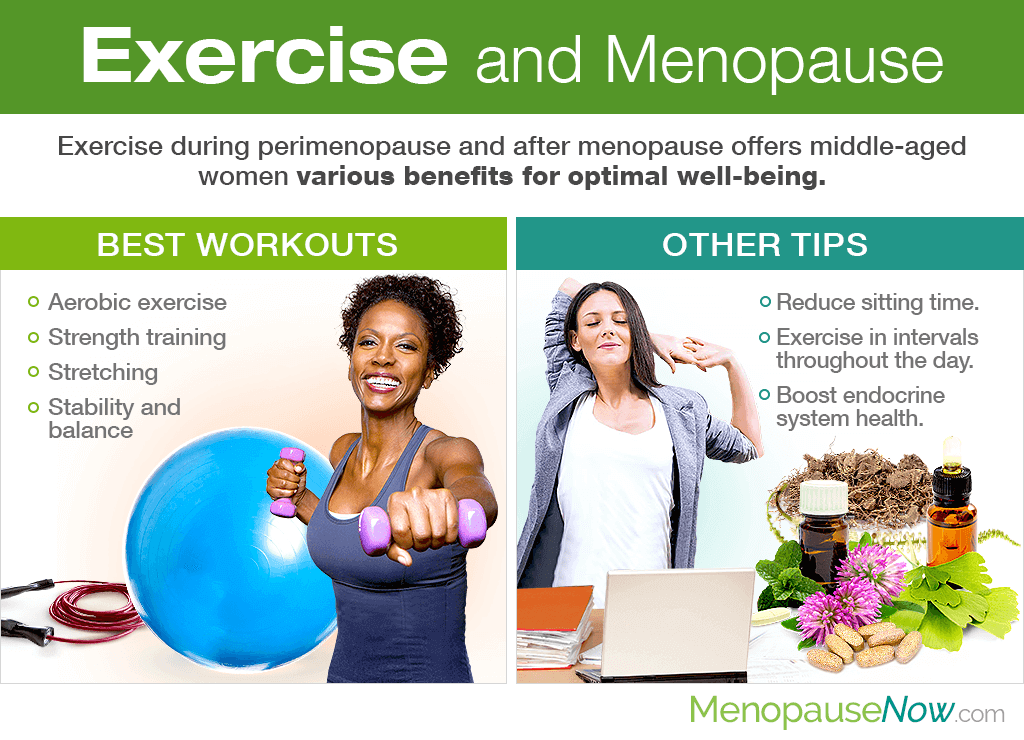Regular exercise is one of the most highly recommended lifestyle changes for women who are looking to promote endocrine system health for hormonal balance. In fact, women exercising regularly report great improvements in symptom severity, including relief from hot flashes. However, not all exercises are created equal. Continue reading to learn all about menopause exercise, including why you need it at this crucial turning point in your life and what are the best exercises for menopause and beyond.
Why Women Need Exercise during Menopause
Exercise during perimenopause and after menopause offers midlife women various health benefits, including:
Elevating mood. It is well-known that any sort of physical exercise leads to a release of endorphins, which are “feel good” hormones. It has also been found that physically active adults have slower cognitive decline and reduced risk of depression.
Reducing stress. At a time when hormonal imbalance can wreak havoc on psychological health, regular exercise helps combat the effects of stress by lowering cortisol levels and reducing tension.
Improving sleep. Sleep disorders are common during the menopausal transition. Fight them with exercise! Studies have shown that exercising regularly reduces the time it takes to snooze, improves sleep quality, and lengthens the amount of time slept.
Strengthening the bones. There is a direct relationship between reduced estrogen levels and the development of osteoporosis after menopause. Therefore, menopausal women who participate in weight-bearing exercises are safe guarding their future bone health.
Keeping a healthy weight. Weight gain is a common symptom of menopause as hormonal imbalance favors the arrival of abdominal fat. As such, regular physical perimenopause and postmenopausal exercise can help maintain a healthy body mass index (BMI).
Reducing the risk of developing diseases. Having excess weight may involve serious implications for your health, including an increased risk of developing heart disease, type 2 diabetes, and various cancers, such as colon, breast, or endometrial.
Best Workouts for Menopause
The best exercises for perimenopause and postmenopause combine aerobic workouts, strength training, stretching, and activities for balance.
Aerobic exercise
Recommendations
Aim for 150 minutes of moderate aerobic activity, 75 minutes of vigorousaerobic activity, or a combination of both each week. Participate in strength training - which is not considered an aerobic activity - at least two to three times a week, alternating days, for the major muscle groups.
Aerobic exercise - or cardio - improves cardiovascular health by strengthening the blood vessels and promoting greater oxygen intake in the body.
Moderate intensity aerobic activity includes swimming, water aerobics, brisk walking, and dancing, while vigorous aerobic activity can be high intensity interval training (HIIT), jogging, running, cycling, and jump roping, among others.
Strength training

After women turn 30, they begin to lose about one percent of muscle mass each year. Because these muscles are what has been burning fat throughout the year, their loss is an ingredient in the recipe for menopausal weight gain later on in life.
As such, strength training - also known as weight-bearing exercises - will help women reduce body fat, strengthen muscles to prevent osteoporosis, and burn calories. Consult with a personal trainer for the most appropriate menopause exercise plan for your fitness needs.
Remember that the goal is to keep building strength by steadily increasing the amount of resistance you use with weights, medicine balls, bands, or other modes. Muscles should tire between 12 to 15 repetitions.
Stretching
Well known for improving flexibility, stretching can help prevent muscles and tendons in the legs and back from stiffening up too much, especially for those menopausal women who work desk jobs for most of the day. Frequent stretching can also help relieve tingling extremities, another unpleasant menopausal ailment.
Try to work stretching into your routine throughout the day and after a menopause workout, which is when muscles are properly warmed up and more receptive.
Stability and balance
Practicing posture, stability, and balance exercises will help menopausal women prevent or lessen pain in the shoulders, neck, and back as well as strengthen their core, among other benefits. They are especially important in aging women who are more vulnerable to falls.
While yoga and tai chi are two of the most popular, practicing stability can be as easy as standing on one leg while brushing your teeth or getting up from your chair while balancing on one leg.
Other Considerations

Aside from getting up and moving with a steady menopause exercise plan, there are further considerations women should take into account.
Reducing sitting time is just as important as working out. Long hours sitting down can heighten one's risk of metabolic issues, negatively impacting health and longevity. This applies even to those who meet the recommended workout guidelines on a weekly basis.
Also, women who don't have time to fit blocks of workout time into their schedules may split up exercises throughout the day. In general, any movement is better than none. Try to partake in at least 30 minutes of moderate activity on a daily basis.
Finally, menopausal women are encouraged to pursue additional natural and effective menopause symptoms treatments. Regular exercise is just a small part of the big picture toward hormonal balance and optimal well-being.
Sources
- AARP. (2018). Got Meno-gut? How to Lose the Belly Menopause Brings. Retrieved June 5, 2019, from https://www.aarp.org/health/conditions-treatments/info-2018/weight-loss-menopause-belly.html
- Anxiety and Depression Association of America. (n.d.). Physical Activity Reduces Stress. Retrieved June 4, 2019, from https://adaa.org/understanding-anxiety/related-illnesses/other-related-conditions/stress/physical-activity-reduces-st
- BMC. (2020). Women's views about physical activity as a treatment for vasomotor menopausal symptoms: a qualitative study. Retrieved October 6, 2020 from https://link.springer.com/article/10.1186/s12905-020-01063-w
- Cleveland Clinic. (2015). Menopause & Osteoporosis. Retrieved June 4, 2019, from https://my.clevelandclinic.org/health/articles/10091-menopause--osteoporosis
- Mayo Clinic. (2016). Fitness tips for menopause: Why fitness counts | Fitness: How much should the average adult exercise every day? Retrieved June 4, 2019, from https://www.mayoclinic.org/healthy-lifestyle/womens-health/in-depth/fitness-tips-for-menopause/art-20044602 | https://www.mayoclinic.org/healthy-lifestyle/fitness/expert-answers/exercise/faq-20057916
- Mishra, N. et al. (2011). Exercise beyond menopause: Dos and Don'ts. Journal of Mid-Life Health, 2(2), 51-56. doi: 10.4103/0976-7800.92524
- National Sleep Foundation. (n.d.). How does exercise help those with chronic insomnia? Retrieved June 4, 2019, from https://www.sleepfoundation.org/articles/how-does-exercise-help-those-chronic-insomnia
- NHS. (2018). Physical activity guidelines for adults. Retrieved June 5, 2019, from https://www.nhs.uk/live-well/exercise/
- The North American Menopause Society. (n.d.). Fitness after 40: Building the right workout for a better body. Retrieved June 4, 2019, from https://www.menopause.org/for-women/menopauseflashes/exercise-and-diet/fitness-after-40-building-the-right-workout-for-a-better-body

